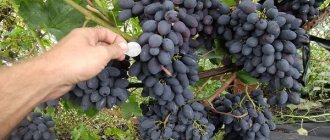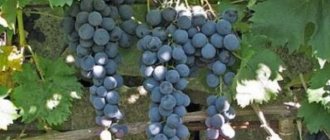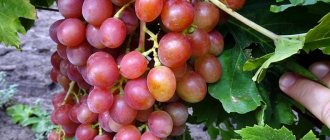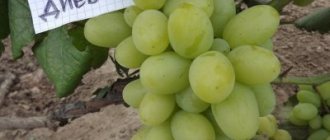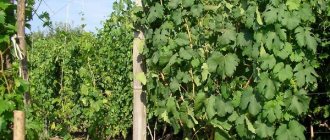At the moment, there are many varieties of Kishmish, but not all of them lack seeds; in fact, there are very few of them. Among them there are also those that contain seeds, but they are very soft and so small in size that you cannot feel them at all when you eat them. one of these is the Rusbol grape, which we will talk about in more detail in this article.
Advantages and disadvantages
Pros:
- Easy to care for.
- Regular high yield.
- High frost resistance.
- Ability to regenerate after freezing.
- Bisexuality of flowers.
- Early ripening.
- The berries are not susceptible to wasp attacks.
Minuses:
- IV class of seedlessness: the presence of rather large rudiments in raisin berries.
- The need for mandatory crop rationing.
- Tendency to cracking of berries at high air humidity for a long time.
- Transportation problems.
Kishmish varieties
There are many varieties of sultanas, but rarely are there ones that have no seeds at all. Many high-quality varieties have rudiments, and the seeds are soft and almost invisible. There is a division into 4 categories of sultana varieties.
- The first and second are characterized by the absence of rudiments. The berries are small, weighing no more than 4 grams.
- In the next two categories, rudiments are felt when eating. The weight of the berries can reach 9 grams.
The presence of rudiments depends not only on the characteristics of the variety, but also on weather conditions. In very hot summers they can reach the size of a full-fledged stone. Such seeds do not germinate and are not suitable for propagation.
Rusbol, or sultana Mirage, belongs to the fourth category. There are rudiments in the berries, but a full-fledged seed is not formed
The hybrid is very popular among gardeners and farmers.
Origin
“Rusbol” is the result of the joint work of employees of the All-Russian Research Institute of Viticulture and Winemaking named after Ya.I. Potapenko and their Bulgarian colleagues. The varieties “super-early seedless” and “villars blanc” were chosen as the “parental pair”. The new hybrid was called “rusbol” and had a lot of positive characteristics. The authors of the successful project are L.A. Maistrenko, A.S. Skripnikova, I.A. Kostrikin, I. Ivanov and V. Vylchev. Parents of “Rusball” are “super early seedless” and “villar blanc”
Advantages and disadvantages of the variety
The breeding qualities of the hybrid make it possible to grow Rusbol in regions with difficult conditions, including in Siberia in unprotected soil. The main advantages of the variety include:
- good resistance to common grape diseases, including fungal ones;
- the ability to form large clusters with calibrated berries, loosely adjacent to each other;
- stability of yields;
- possibility of propagation by cuttings;
- ability to withstand low temperatures.
The disadvantage of this variety is that it quickly loses its presentation during long-term transportation. Excessive humidity and prolonged rain may cause cracking of fruits and rotting of berries.
Main characteristics
“Rusbol” is an excellent raw material for the production of high-quality raisins. It can also be consumed fresh; the variety also produces good Muscat wine. The low calorie content of the product (100 kcal per 100 g) allows you to include these grapes in your diet.
Ripening period
The duration of the growing season for grapes is 115 – 125 days. This allows us to classify “rusbol” as a group of varieties with early ripening.
Bush
The bush of the variety is considered medium-sized: its maximum height reaches 3.5 m. In southern latitudes, the plant is formed on high trunks, in the northern regions - on low ones, leaving sleeves of medium length. A short sleeve option is available.
The foliage is dense, dark green, jagged. The average size of the leaf plate is 6 by 8 cm. The antennae are small and thin.
Rusbol bush
The flowers of the plant are bisexual, with a strong aroma, which attracts insects, which subsequently successfully pollinate all plants growing nearby.
Important! The number of inflorescences on a bush is large, and so that in the future it simply does not die under the weight of the brushes, some of the flowers must be removed, and too large inflorescences must be shortened. The bunches will only benefit from such a measure: the berries will be large and juicy, and the bush will safely produce new fruit-bearing shoots.
Bunches and berries
The bunches of “rusbol” are large and heavy. On average, their weight ranges from 400 to 600 g, but with proper care the weight can reach 1 kg or more. Their shape is conical, medium density structure. On each shoot 1.5 - 1.8 clusters are formed. How to properly tie grapes to a trellis is written in a separate article.
Oval berries of amber-yellow color can weigh up to 4 g and reach sizes of 1.8 by 1.6 cm. The pulp is dense, containing rudiments, the average weight of which ranges from 40 to 60 mg. The skin is thin, almost imperceptible when eaten. The berries are quite sweet: 19–21% sugar with 5–8 g/l acid.
Taste
The taste of the variety does not have a complex bouquet, but at the same time it is harmonious in its simplicity. Light nutmeg notes dissolve in sweetness, not cloying, but pleasant.
The assessment of the organoleptic properties of fresh grapes is quite high - 7.6 points, dried fruit - 7.8 points.
Rusbol grapes: how to properly cover a grapevine
The time when it is time to cover the plants depends on the weather. It is important to know that you cannot cover the vine in advance, as the eyes will spray. But you can’t skip the onset of cold weather in order to protect the root system and prevent it from being damaged.
- After the autumn pruning has been carried out, the plant must be left for some period of time to prepare for the winter cold. Do not rush to cover the plant as soon as the first frosts appear, because hardening will be beneficial to the vine, so you should not take any measures up to -5 degrees.
- The root system of Rusbol is less resistant to winter cold, unlike its branches, so it is necessary to start insulating it from there. For this, humus mulch is suitable, which must be applied in a layer of 10 centimeters.
- The branches are carefully wrapped, making bundles of them, lowered to the ground, leaning against roofing felt, wood or plastic.
- The soil and branches must be treated with a solution of copper sulfate in accordance with the instructions, this will help protect the plant from infections.
- The next step is to cover the plant with intransitive material. Some people use soil, covering the bush with it, but such shelter is likely to damage the eyes, which can rot due to dampness.
An excellent option for shelter would be mulching with spruce branches, spandex and film thrown over the arches and secured in such a way that in the event of a strong wind it will not be blown away. It is important to leave a small hole to allow the plant to ventilate.
Features of cultivation
Even a novice gardener can grow “rusbol”, but do not forget about timely rationing of bushes and it will please you with a good harvest in August.
Landing
“Kishmisha” varieties, including “Rusbol”, are best planted in the southern regions in the fall, and in the middle zone and Moscow region - in the spring. Spring planting is usually carried out in late April - early May and requires the winegrower to systematically water the young seedlings during the hot summer. In autumn, planting occurs a month before the first frost. The winegrower should remember that tender seedlings need reliable protection from frost.
Place and soil
“Rusbol” prefers light shading created by neighboring shrubs and low trees. He doesn’t mind a light breeze blowing in the area, which will significantly reduce the risk of infection with fungal diseases. Groundwater should not come closer than 3 meters to the soil surface, otherwise the plant may be affected by root rot.
“Rusbol” loves loam with low acidity. If, however, the soil is acidified, then before planting it is necessary to liming it. To do this, 2 kg of lime should be diluted in 10 liters of warm water, and the area should be spilled with this solution at the rate of 20 liters per sq.m. The ideal soil for grapes is written in a separate article.
For better productivity, the soil must be pre-fed before planting: 2 kg of humus and 1 bucket of compost per 1 sq.m.
The recommended dimensions of the planting hole are 100 by 100 cm, depth - 80 cm.
The landing technology is standard. Drainage is poured into the bottom to allow air circulation and drainage of excess liquid from the roots of the plant. Next, an iron rod or other support is driven into the center of the hole, which will support the young seedling and guide its growth. The culture is placed in the hole, the roots are evenly distributed over its area, after which the root system is covered with earth and watered with 20 liters of warm, settled water.
Attention! The first fruiting of a young plant is observed already in the second year after planting.
Watering and fertilizing
It is necessary to water the “rusbol” 3 months after planting, 20 liters of water per bush. Further - as the soil dries out. Recommended frequency: once every 20-25 days.
Along with water, fertilizers can also be added to the crop.
- A month after planting, to improve the growth of grapes, it is necessary to add potassium nitrate (20 g per 10 l).
- At the beginning of June - superphosphate (30 g per 10 liters of water).
- 3 - 4 weeks before harvesting, you need to add a solution of ammonium nitrate to increase the size of the brushes (60 g per 10 liters of water, 20 liters per bush).
Trimming
The uniqueness and undeniable advantage of “rusbol” is the absence of the need for regular pruning of shoots. If, nevertheless, the winegrower is accustomed to such measures for caring for the plant, then 8 eyes can be left on the shoot. In the spring, you should definitely remove all dried areas, and in the summer, branches with signs of disease.
Diseases and pests
“Rusbol” demonstrates good resistance to diseases, but it can still “catch” powdery mildew, mildew, and olive spot. Ankacitron (50 g per 10 l), Regent (10 g per 10 l), Phosfarin (60 g per 5 l of water) will help cope with such problems, respectively.
Copper sulfate will help prevent the occurrence of fungal diseases.
The first treatment is carried out in the spring before the buds open on the plant (50 g per 10 liters of water); the bushes can be re-treated with this product in the fall, using a more concentrated solution (300 g for young seedlings and 500 g for an adult plant per 10 liters of water).
“Rusbol” is vulnerable to aphids, fleas and mites, but they can be easily destroyed with the help of insecticides:
- For aphids: Oxychom – 80 g per 5 l.
- For fleas: Khomus – 20 g per 5 l.
- For ticks: cayenne pepper solution – 2 g per 5 liters of water, once every 15 days.
Wintering
This variety was created specifically for cultivation in regions with a temperate climate. The plant is able to withstand frosts of -25ºС without shelter, but only if there is a snow thickness of 50 cm. Young seedlings still need to be insulated: they still do not have enough strength to resist a significant drop in temperature. It is recommended to cover plants in the first 3 years of their life.
Harvest storage
The thin skin of sultanas does not allow the berries to sit for a long time; for the same reason, transportation of “rusbol” is also problematic. If optimal storage conditions are created (temperature close to zero and high humidity in the room), the brushes will remain suitable for consumption for 1 month, maximum 2.
Reference! The variety is high-yielding: up to 30 kg of fruit can be harvested from one bush per season.
Regions
The variety can be safely grown in the Moscow region and in more northern regions, not to mention the south of the country.
Ways to protect yourself from diseases
Rusbol suffers most from various types of fungi. They cause many species diseases, such as gray mold, oidium and mildew. These diseases are most dangerous in the warm and humid season. The most commonly used fungicide is copper sulfate, and gardeners also use fungicides.
It is necessary to treat bushes for preventive purposes even before the buds appear. Copper sulfate at a dosage of 0.5 percent in an amount of 20 grams must be dissolved in a bucket of water. After the leaves fall in the fall, you need to treat the bushes again. For young plants, a three percent solution will be required, and for adults, a five percent solution.
The Rusbol hybrid produces a consistently stable harvest, independent of climatic conditions. It tolerates harsh winters well, but does not like high humidity. The variety is very popular among farmers, as the berries do not crack, are easily transported and are a rare sultana species. You can make juices and compotes from the fruits for the winter. The berries are used for desserts and eaten fresh. They are also dried to produce raisins. The fruits contain only rudiments and no seeds. The taste qualities of the berries are evaluated by producers and amateur gardeners.
Comparison with analogues
The main comparison parameters between “rusbol” and other raisin varieties are presented in the table.
| Sign | Variety | |||
| Rusbol | Kishmish Radiant | Kishmish No. 342 (Hungarian) | Jupiter | |
| Ripening period | 115 – 125 days | 125 – 130 days | 110 – 115 days | 110 – 125 days |
| Frost resistance | -25C | -22C | -26C | -29C |
| Yield per bush | Up to 30 kg | 20 – 30 kg | 20 kg | 25 kg |
| Bunches | 400 g – 1.5 kg | Up to 1 kg | 300 – 500 g | 250 – 500g |
| Taste | Light nutmeg | Nutmeg flavor | Nutmeg flavor | Muscat with strawberry aftertaste |
| Color | Amber | Hot pink | Green-golden | Dark blue |
| Disease resistance | Above average | Above average | High | High |
| Shelf life | 1 month | 1 month | 1 month | 3 months |
| Sugar content | 19-21% | 17-21% | 19-21% | 22-23% |
| Acidity | 5.5-7.5 g/l | 6.5-7.5 g/l | 6-8 g/l | 5-6 g/l |
Varieties
Breeders did not stop at breeding this grape variety. They improved it, resulting in 2 varieties of Rusobol.
Improved
The variety was created on the basis of Rusbol and Delight. The ripening period for improved Rusbol grapes is 105-115 days. Its fruiting can begin as early as the next year after planting. The variety's clusters reach 900 grams, the length of the berries reaches 2 centimeters.
Muscat
On the basis of Rusbol and Bulgaria stable, Rusbol nutmeg was bred. It has the same basic characteristics as other Rusbols, but there is a difference - nutmeg taste and aroma.
The berries store well and can turn into raisins even in room conditions.
Photo
Below, check out the photos and reviews about the “Rusbol” variety.
Reproduction methods
The formation of large plantings of grapes requires significant costs for the purchase of seedlings. The Rusbol variety allows you to avoid this, as it reproduces well by layering and cuttings.
Cuttings
Using cuttings, you can obtain a large number of seedlings and quickly increase the area under grape planting. The material is prepared in advance; for this, healthy and strong shoots are selected in the fall and cuttings 7-12 cm long are cut from their middle part so that the length of the internodes is about 10 cm, and there are 3-4 developed buds. The leaves and tendrils are removed, the shoots are placed in water and disinfected with copper sulfate.
After drying, the cuttings are stored until spring in a cellar at a temperature of +5 0C, placing them in boxes with wet sand.
In March, the cuttings begin to germinate. To do this, their ends are placed in a solution of a growth stimulator and additional lighting is provided. After the roots appear, the cuttings are planted in containers with soil for transplanting to a place of permanent cultivation in May.
By layering
Reproduction by layering can be deep or horizontal. The first option is used to replace adult grape bushes. To do this, in the spring, dig a ditch the width of a shovel and 0.5 m deep. The outermost shoot is placed in it, bringing the top out in the middle of the ditch and cutting it off by 5 cm, sprinkled with earth and cared for during the season as if it were an adult plant. In the 3rd year, the young bush can be separated from the parent bush.
If horizontal layering is used, shallow grooves of 10 to 20 cm are dug into which the grape shoot is placed. It is pressed with slingshots and covered with a mixture of earth and peat, leaving a mound 10 cm high. A film is placed on top of the ground to prevent moisture evaporation; as soon as shoots appear, it is removed. In the fall, cuttings are dug up and divided into individual seedlings. The root system is immersed in a clay solution and the cuttings are sent to the cellar for storage. In the spring, a 15 cm groove is formed and they are planted, cutting off the above-ground part and sprinkling with fertile soil.
Reviews
Rusbol is very productive - I leave 2 inflorescences, but the 2nd and 3rd, because... The 1st is usually huge and requires care when cutting. Unpretentious in terms of care, resistant to frost and disease. Georgiy, Dnepropetrovsk region.
If I were asked which variety with minimal care is capable of producing a high yield, then I would undoubtedly answer - RUSBOL. Vitaly, Voronezh
A very productive variety, seedless, harmonious taste and children love it very much. Ivan Ivanovich, Uzhgorod, Ukraine
Diseases and pests
Despite good immunity, Rusbol grapes are sometimes affected by certain diseases and pests.
Gray rot
This fungal disease affects the above-ground part of the bush. A gray coating appears on the leaves, the berries wither and fall off. Fungicides are used against the disease, for example, Horus, Insegar.
Oidium
Oidium appears as a white coating on berries and leaves. They seem to be dusted with flour. Bushes are sprayed against fungal diseases with the following preparations: Karatan, Bayleton.
Anthracnose
With this disease, rapidly growing brown spots appear on the leaves. To prevent the appearance of the disease in the spring, grapes are sprayed with copper-containing preparations.
Mildew
This is downy mildew. Yellow spots with white fluff form on the leaf blades. To prevent the disease, the bushes are irrigated with Bordeaux mixture in the spring.
Olive spot
Light yellow spots about 1 centimeter in diameter appear on the aerial parts. To prevent the disease, remove plant debris from the tree trunk, spray the bushes with Bordeaux mixture, and increase immunity by applying fertilizers.
Description
Improved Rusbol is a new form of seedless table hybrid.
Such grapes are called “kishmish”. The variety received its name from one of the parents of the breeding pair. Russian researchers from VNIIViV named after. ME AND. Potapenko crossed Rusbol grapes with a seedling of the hybrid form I-15-3-1, bred from the “Villars Blanc” and “Vostorg” varieties. The second name of the variety is “Elf”. The seedlings have good rooting ability. The first year the bush is formed. Shoots of high maturity The vine grows above average or very tall. It is advisable to use trunks when forming a bush. Grapes enter the fruiting stage only in the second year of growth. The wait is worth it. At harvest, the vine is abundantly decorated with large, beautiful conical-shaped clusters. The cut bunch, thanks to the medium-loose formation of the berries on a branched cluster, retains its shape. The weight of one cluster is impressive. On average it ranges from 700 to 900 grams. The largest ones reach a mass of one and a half kilograms. The shoots are characterized by good ripening. The grapes are also unpretentious to popular types of rootstocks. Compatibility is high.



